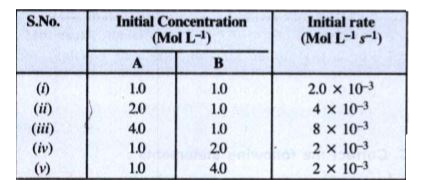The initial rate of reaction , was measured for several concentration of A and B. The decomposition made are recorded in the following table.

Using the data in the above table, determine a) the rate law for the reason b) the magnitude of the rate constant.
The rate law may be expressed as:
Rate =
Comparing experiments (1) and (2),
…………(i)
…………….(ii)
Dividing eqn. (ii) by (i),
=1
or q=0
Comparing experiments (1) and (3),
or p=2
Order w.r. to A=2, Order w.r. to B=0
Rate law for the reaction
Value of rate constant from expt:1.
.
Topper's Solved these Questions
- BOOK - DINESH PUBLICATIONCHAPTER - CHEMICAL KINETICSEXERCISE - Additional Numerical Problems For Practice16videos
CHEMICAL KINETICS
- BOOK - DINESH PUBLICATIONCHAPTER - CHEMICAL KINETICSEXERCISE - Brain storming Multiple choice questions.10videos
CHEMICAL KINETICS
- BOOK - DINESH PUBLICATIONCHAPTER - CHEMICAL BONDING AND MOLECULAR STRUCTUREEXERCISE - Unit Test - 120videos
CHEMICAL BONDING AND MOLECULAR STRUCTURE
- BOOK - DINESH PUBLICATIONCHAPTER - CHEMICAL THERMODYNAMICS AND CHEMICAL ENERGETICS EXERCISE - Exercise507videos
CHEMICAL THERMODYNAMICS AND CHEMICAL ENERGETICS
Similar Questions
Knowledge Check
- Question 1 - Select One
Use the experimental data in the table to determine was studies

What is the rate equation for the reaction ?ARate= k[A][B]BRate= k[A]2CRate= k[B]DRate= k[B]2 - Question 2 - Select One
For a reaction between A and B, the initial rate of reaction is measured for various initial concentrations of A and B . The data provided are :

The overall order of the reaction is :Aone(1)Btwo (2)Ctwo and a half (2.5)Dbetween 0 and 1 - Question 3 - Select One
For a reaction between A and B, the initial rate of reaction is measured for various initial concentrations of A and B. The data provided are

The overall order of the reaction isAoneBtwoCtwo and halfDthree
Consider the reaction, A+B→C+D.
The initial rate for different initial concentrations of the reactants are given below :

Calculate the rate constant.View SolutionConsider the reaction, A+B→C+D.
The initial rate for different initial concentrations of the reactants are given below :

Calculate the rate constant.View SolutionConsider the reaction, A+B→C+D.
The initial rate for different initial concentrations of the reactants are given below :

Calculate the rate constant.View SolutionFor the reaction 2A+B → product, doubling the initial concentrations of both the reactants increases the rate by a factor of 8 and doubling the concentration of B above double the rate. This rate-law for the reaction is
View SolutionFor a reaction ,A+B→C data is as follows :

the rate law for the reaction isView Solution


